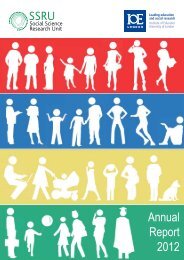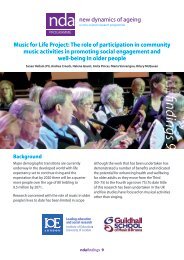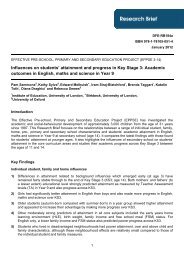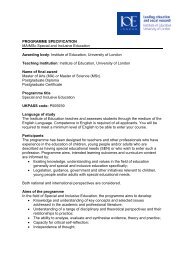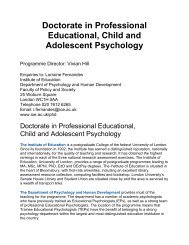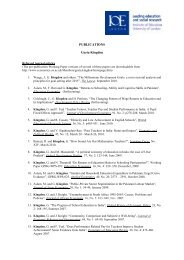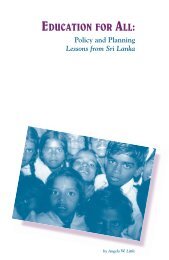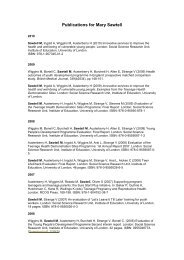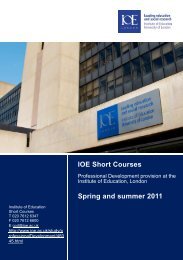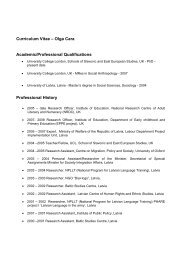Working paper 1 (pdf - Institute of Education, University of London
Working paper 1 (pdf - Institute of Education, University of London
Working paper 1 (pdf - Institute of Education, University of London
Create successful ePaper yourself
Turn your PDF publications into a flip-book with our unique Google optimized e-Paper software.
interviewed (eight out <strong>of</strong> eleven) had children in primary schools. When they were asked to indicate<br />
where their children went to school, virtually all <strong>of</strong> them said their children went to school in other<br />
schools and mostly private schools in the local area. On a later field visit one <strong>of</strong> the few male teachers<br />
was driving his own children home from the school, and appeared the only teacher to have children<br />
attending the school.<br />
The poverty in the two sites and the way it affects the lives <strong>of</strong> children is visible in both schools,<br />
described by researchers as manifested in tattered uniforms, hungry children, and absenteeism.<br />
However it also appears to be a means by which teachers and those in “authority” (including<br />
members <strong>of</strong> the school governing board) further distance themselves from the community, the<br />
children in their school and their parents. This distancing was evident in many <strong>of</strong> the comments made<br />
by the two principals, and teachers and SGB members interviewed in Kenya. The South African head<br />
teacher, when describing the poverty experienced by pupils in the school says:<br />
Even if you visit their places you can be shocked. Ay, this place… is this place for a human<br />
being or is this place just for an animal!<br />
When talking about the area he also describes the crime, and problems with drugs.<br />
In the Kenyan school the head teacher describes parents coming from the slum area saying,<br />
these are very lower class people who have received little education.<br />
This lack <strong>of</strong> participatory dialogue between members <strong>of</strong> the school community and the local<br />
neighbourhood might be a contributory process to the establishment <strong>of</strong> the sharp binaries mapped<br />
above. Policy is heard from a long way <strong>of</strong>f, and this is counterposed with the „real‟ work <strong>of</strong> practice<br />
which is peopled not by logical diagrams <strong>of</strong> equality but relationships <strong>of</strong> shock and distance from the<br />
nature <strong>of</strong> the poverty. The formal relations <strong>of</strong> employment or enrolment where gender parity might be<br />
required are counterposed with the „natural‟ relationships <strong>of</strong> care „for the needy‟ in which relationships<br />
are not between equals. Thus the different meanings <strong>of</strong> gender appear to undercut each other in a<br />
context <strong>of</strong> poverty. While the sense <strong>of</strong> gender as a noun (girls and boys) identified in many policy<br />
directives (Unterhalter, 2007) is something that is possibly achievable in contexts <strong>of</strong> poverty when<br />
there is a limited focus on improving numbers enrolled in school (Rose & Dyer, 2006, 2008) , the<br />
more detailed analysis <strong>of</strong> chronic poverty that looks at its multidimensionality, including duration and<br />
dynamics, particularly intergenerational transfer, social discrimination and inability to have rights<br />
recognised (CPRC, 2008) raises wider problems regarding how gender is understood. The<br />
disconnections evident between many teachers and the families living in the communities in which<br />
they work make it difficult to build collective strategies to explore this.<br />
There appear to be no spaces where the distancing and the binaries this generates can be discussed.<br />
It is unlikely the sweeping statements articulated by the members <strong>of</strong> the SGBs had been developed in<br />
dialogue with members <strong>of</strong> the local community as the links appear primarily formal. Teachers‟ views <strong>of</strong><br />
the community and the dynamic <strong>of</strong> gender relations are largely from the outside looking in. Further<br />
areas for research concern what members <strong>of</strong> the community, who are not invited via the school<br />
structures, think about gender issues and education and what strategies might help build more<br />
participatory forums for discussing gender, poverty and education in the two sites.<br />
Poor parents and the problem <strong>of</strong> girls<br />
One consequence <strong>of</strong> the social distance between the teachers and the communities in which they live<br />
has been the emergence <strong>of</strong> a pronounced emphasis <strong>of</strong> blame, particularly <strong>of</strong> girls and <strong>of</strong> poor parents.<br />
The similarities in these attitudes in the two research sites were striking.<br />
Poverty is clearly a very real – and overwhelming – problem in both schools. It is mentioned in<br />
numerous occasions in the interviews and comes up in the researchers‟ field notes. In the South<br />
African school poverty is very clearly seen as a more urgent problem than gender that affects pupils in<br />
the school. Tellingly, when the head teacher was asked by the interviewer which <strong>of</strong> the gender issues<br />
in the school he sees as most pressing he replies “Its poverty. Its poverty”. Elsewhere he talks about<br />
18



